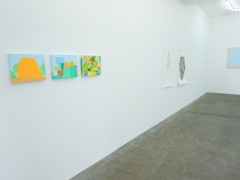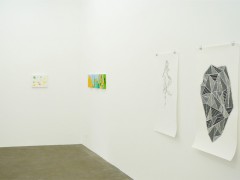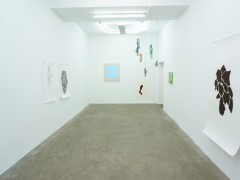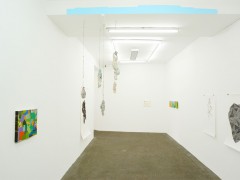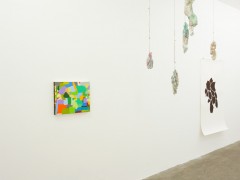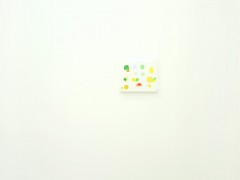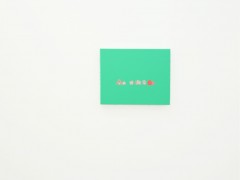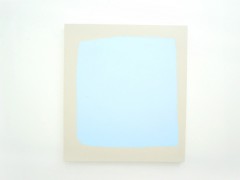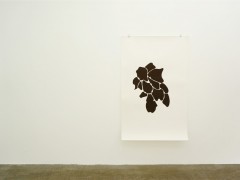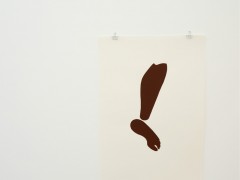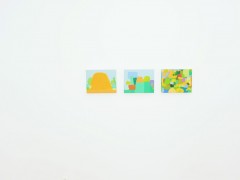Naufus Ramirez-Figueroa & Federico Herrero – Zipacna, the creator of mountains
22.03 – 15.05 / 2014
Galerie Sultana, Paris
The Popol Vuh or “Book of the People” is an epic mytho-historical narrative written by anonymous members of the Quiché-Maya nobility, a branch of the Maya that dominated the highlands of western Guatemala prior to the arrival of the Spanish conquistadors in 1524. Their present population is something over half a million, spread thinly through a series of market towns and smaller agricultural villages in the modern Guatemalan states of Quiché, Totonicapán, and Quetzaltenango.
The story goes that Zipacna, a demon, is challenged by Hunahpu and Ixbalanque, the two divine hero twins, who decide to exact revenge upon him for the death of the Four Hundred Boys, a group of 400 patron deities of alcohol who had previously tried to kill him after considering his overwhelming strength an aberration. In a fascinating account that deals with arrogance, revenge, fear, and the creation of the universe, Zipacna is finally killed through a scheme in which an elaborate fake crab –his favorite food– is constructed and hid it deep in a canyon. This has raised multiple interpretations, including that of death as punishment for sexual desire.
Zipacna, Creator of Mountains, a collaboration between Proyectos Ultravioleta (Guatemala City) and Galerie Sultana (Paris), brings together the work of two of the most interesting young Latin American artists working today: Federico Herrero, renowned painter and sculptor from Costa Rica, and Naufus Ramírez-Figueroa, multi-disciplinary artists from Guatemala. The exhibition revolves around a piece of fan fiction by Ramírez-Figueroa in which the artist introduces himself into a version of Zipacna’s Popol Vuh tragedy that works as both an homage and mockery of the mythical anti-hero.
The work of both artists, from clearly different perspectives yet profoundly in tune, provides a setting of sorts for the literary meta construction created by Ramirez-Figueroa in the eponymous tale. Federico Herrero’s paintings are speculative interpretations of the beach where Zipacna was basking when disturbed by the Four Hundred Boys, the hole where they tried to bury him and the canyon where he is finally caught by Hunahpu and Ixbalanque as well as of different characters in and out of the story. The works also hold one of Herrero’s recurring elements: the portals to other dimensions as conveyed by the plain fields of color on the canvases, in this case, perhaps a door to the dimension of the Popol Vuh and in particular the moment where Zipacna’s story (and Naufus’ reinterpretation) might take place. Herrero’s construal of a possible Guatemalan landscape has a precedent in his 2011 exhibition at Proyectos Ultravioleta, Catarata.
On the other hand, Ramírez-Figueroa’s series of silk-screen prints are based on automatic drawings inspired by Zipacna’s story and, by a long historical extrapolation, also a commentary on the current state of indigenous communities in Guatemala, particularly in the light of recent political events such as the contested genocide that took place partly where the Popol Vuh was written in the early 1980s. Drawing from a long art historical tradition, these prints also refer to the artist’s concern with a contemporary indigenous identity and it’s unapproachability by non-members of the community.
When Zipacna goes down the canyon to fetch the crab guided by either hunger or sexual appetite according to contrasting interpretations, the Hunahpu and Ixbalanque collapse a mountain over him suggesting the vengeance of his own creations and an association with Cabrakan (Earthquake), the destructor of mountains, his brother. Following the unwrapping of the story, two sculptures and an audio piece by Ramírez-Figueroa round up the exhibition: the arm of Cabrakan who was killed after eating a poisoned bird, and a monkey head, an allusion to Guatemala’s more recent traditional artistic practices.
Zipacna, Creator of Mountains is an excursion into the Popol Vuh, imaginary landscapes, and some of the myths around history, indigenous identity and art production. Through remarkable coincidences in terms of subject matter and artistic sensibility, although through different techniques and forms, both Herrero and Ramírez-Figueroa provide glimpses into a dark yet fascinating version of the creation of the mountains, the beginning of the universe.
Federico Herrero (1978, Lives and works in San Jose, Costa Rica) is an artist who makes paintings wich in the space often extend beyond the canvas and play with the notion of perception of time and space. Recent exhibitions include : Letras y numeros at Galeria Luisa Strina; Novo Museo Tropical, Teoretica San Jose ; Aloha amigo, 21st Century art Museum of Kanazawa;» Panamericana, Kurimanzutto, Mexico City, 2010, Bienal de Pontecedra 2010; and Do it, catalogue and touring exhibition. He also has shown at Venice Bienale 2001, Urgent Painting at Musée d’art moderne de la Ville de Paris 2002; La Habana Bienale 2003; Empty Garden at the Watari Museum Tokyo 2004; Moscow Biennale 2006; Singapore Biennale 2006, Venice Bienale 2008, Passengers at Wattis Institute San Francisco 2008; Segunda Trienal Poligrafica del Caribe Puerto Rico 2009 and Panorama 33 at the Museo de Arte Moderno de Sao Paulo MAM in 2013. Herrero is also founder of Des Pacio, a space for contemporary art located in San Jose Costa Rica that has been supporting local artists and activating the contemporary arts scene in central America since 2007.
Naufus Ramírez-Figueroa (Guatemala City, 1978) holds a BFA from Emily Carr University and an MFA from the School of the Art Institute of Chicago. The Guatemalan civil war (1960-96) is a recurring subject in his work, which although often softened by an absurd and humorous approach, fails to conceal the force of history that precedes it. Ramírez-Figueroa has participated in various solo and group exhibitions including the 53rd Internationale Kurzfilmtage Oberhausen (Oberhausen, Germany), Home Works IV (Ashkal Alwan, Beirut, Lebanon), AA Bronson’s School for Young Shamans (John Connelly Presents, NY), Illy Present Future 2013 (Castello di Rivoli, Italy) and has presented solo projects at Proyectos Ultravioleta (Guatemala City) and Casa América (Madrid). He is a recipient of a Guggenheim fellowship, a Franklin Furnace award, and an Akademie Schloss Solitude fellowship (selected by Dan Graham). Future projects include a commission to present a mayor sculptural installation at the 10th Gwangju Biennale in the fall of 2014. Ramirez-Figueroa lives and works in Guatemala City, Guatemala, but is currently a resident at the Jan Van Eyck Academie in Holland.
Practical informations
12 rue des arquebusiers
75003 Paris
tuesday saturday, 11am 7pm or by appointment.


 Home
Home
